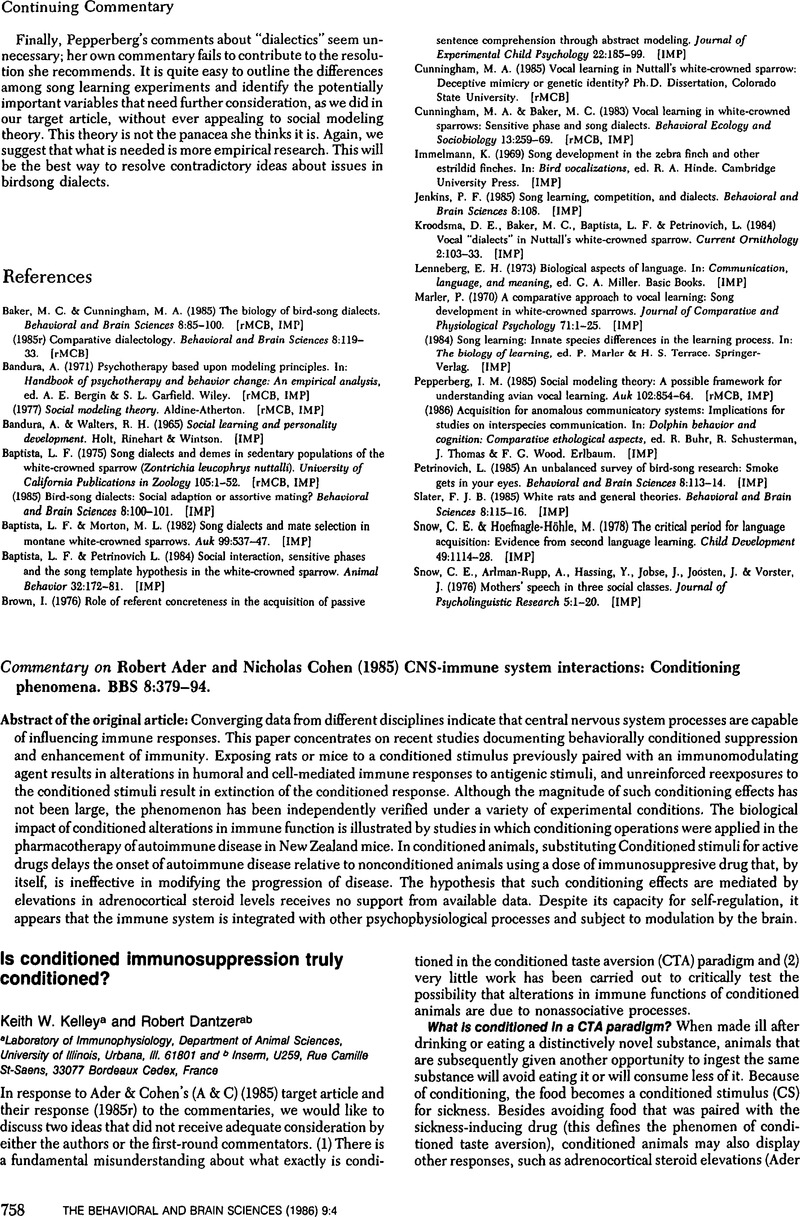Crossref Citations
This article has been cited by the following publications. This list is generated based on data provided by Crossref.
Furedy, John J.
1989.
Flights of teleological fancy about classical conditioning do not produce valid science or useful technology.
Behavioral and Brain Sciences,
Vol. 12,
Issue. 1,
p.
142.
Wickram, Ian
1989.
Classical conditioning and the placebo effect.
Behavioral and Brain Sciences,
Vol. 12,
Issue. 1,
p.
160.
Westland, James Christopher
and
Kochen, Manfred
1989.
Classical conditioning: A manifestation of Bayesian neural learning.
Behavioral and Brain Sciences,
Vol. 12,
Issue. 1,
p.
160.
Fields, Chris
1989.
Explaining classical conditioning: Phenomenological unity conceals mechanistic diversity.
Behavioral and Brain Sciences,
Vol. 12,
Issue. 1,
p.
141.
Dworkin, Barry R.
1989.
Learning and functional utility.
Behavioral and Brain Sciences,
Vol. 12,
Issue. 1,
p.
139.
Riley, Anthony L.
1989.
Classical conditioning: A parsimonious analysis?.
Behavioral and Brain Sciences,
Vol. 12,
Issue. 1,
p.
157.
Gardner, Beatrix T.
and
Gardner, R. Allen
1989.
Beyond Pavlovian classical conditioning.
Behavioral and Brain Sciences,
Vol. 12,
Issue. 1,
p.
143.
Klosterhalfen, Wolfgang
1989.
A promising new strategy for studying conditioned Immunomodulation.
Behavioral and Brain Sciences,
Vol. 12,
Issue. 1,
p.
150.
Turkkan, Jaylan Sheila
1989.
Classical conditioning: The new hegemony.
Behavioral and Brain Sciences,
Vol. 12,
Issue. 1,
p.
121.
Kehoe, E. James
1989.
Associative theory versus classical conditioning: Their proper relationship.
Behavioral and Brain Sciences,
Vol. 12,
Issue. 1,
p.
147.
Jacobs, W. J.
1989.
What is classical conditioning?.
Behavioral and Brain Sciences,
Vol. 12,
Issue. 1,
p.
146.
Lloyd, Dan
1989.
Extending the “new hegemony” of classical conditioning.
Behavioral and Brain Sciences,
Vol. 12,
Issue. 1,
p.
152.
Fantino, Edmund
1989.
Response utility in classical and operant conditioning.
Behavioral and Brain Sciences,
Vol. 12,
Issue. 1,
p.
141.
Locurto, Charles
1989.
The dark side of hegemony.
Behavioral and Brain Sciences,
Vol. 12,
Issue. 1,
p.
153.
Bersh, Philip J.
and
Whitehouse, Wayne G.
1989.
The domain of classical conditioning: Extensions to Pavlovian-operant interactions.
Behavioral and Brain Sciences,
Vol. 12,
Issue. 1,
p.
137.
Domjan, Michael
and
Nash, Susan
1989.
Conditioning of sexual and reproductive behavior: Extending the hegemony to the propagation of species.
Behavioral and Brain Sciences,
Vol. 12,
Issue. 1,
p.
138.
Samar, Vincent J.
and
Berent, Gerald P.
1989.
Classical conditioning and language: The old hegemony.
Behavioral and Brain Sciences,
Vol. 12,
Issue. 1,
p.
158.
Krank, Marvin D.
1989.
Pavlovian conditioning: Providing a bridge between cognition and biology.
Behavioral and Brain Sciences,
Vol. 12,
Issue. 1,
p.
151.
Lacey, Hugh
1989.
Classical conditioning beyond the laboratory.
Behavioral and Brain Sciences,
Vol. 12,
Issue. 1,
p.
152.
MacQueen, Glenda
MacRae, James
and
Siegel, Shepard
1989.
Contiguity, contingency, adaptiveness, and controls.
Behavioral and Brain Sciences,
Vol. 12,
Issue. 1,
p.
154.



